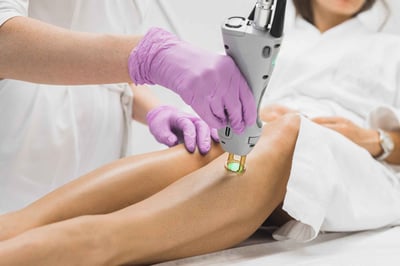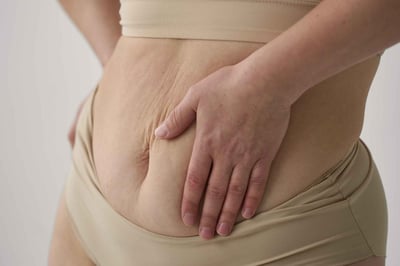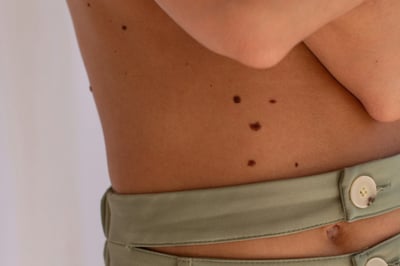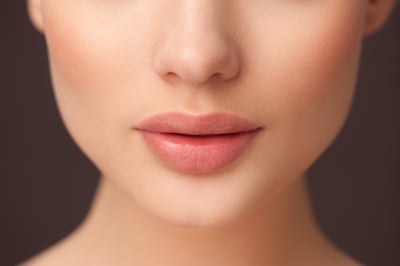Acne Scarring
Acne is a common problem that affects most people at some point in life. However, if it's not treated properly, it can linger and leave behind scars. The good news is that those kinds of scars are no longer permanent. There are treatments available that can reduce the appearance of acne scars, giving you back confidence and peace of mind. Whether you choose laser treatments, microneedling, chemical peels or topical creams and solutions, there are many options to consider. Don’t let acne scarring keep you from living your best life. With commitment and dedication the journey towards beautiful, clear skin can truly begin!

What is Acne Scarring
Acne scarring occurs when a breakout penetrates the deep layers of skin and causes damage to the connective tissue. Although they often vary in appearance, they may look like indentations or raised bumps on the skin. If left untreated, acne scarring can be permanent. Despite many possible treatments, improving scars created by acne can be a challenging and lengthy process that requires patience and dedication. Thankfully, there are now several topical treatment options available to diminish the appearance of scars created by acne .Additionally, more aggressive medical procedures may be necessary for more severe cases of scarring.
What many don’t realize is that there are now effective treatments available to reduce and even eliminate the appearance of scarring. Laser treatments, chemical peels, microneedling and other treatments can help improve the look and feel of acne scars caused by cysts or nodules on any part of the body. Consulting a medical professional who can tailor an effective treatment plan and provide more information on options best suited for each personal skin type is imperative. Preventing acne scarring starts with proper hygiene including avoiding harsh scrubbing and sticking to only gentle cleansers and moisturizers formulated specifically for the face.
Common Types of Acne Scarring
There are typically three types of acne scarring - ice pick scars, boxcar scars, and rolling scars. Ice pick scars have steep edges and a deep, narrow base caused by nodular or cystic acne. Boxcar scars are round or oval shaped depressions in the skin due to severe inflammation from nodular or cystic acne. Rolling scars have enlarged pores and an uneven texture from inflammatory acne lesions.
Ice pick scars
Ice pick scars are a common, yet unfortunate result of acne. These deep and narrow scars can extend several millimeters into the skin and create pitted surface irregularities in the affected area. Depending on the severity of the scarring, treatments like dermabrasion, laser resurfacing, chemical peels and topical creams are generally recommended as corrective options to help restore a smoother complexion. For those suffering from severe ice pick scarring, consulting a medical professional should be your first step to healing a damaged complexion.
Boxcar scars
Boxcar scars are one of the most common types of facial scarring, and they occur when the skin’s tissues become excessively damaged. Boxcar scars appear as small depressions on the skin that create beveled edges. While these scars can certainly cause individual distress, there are several treatments available to reduce their appearance. Laser resurfacing can help smooth out the contours around box car scars, or there are chemical peels and microneedling options Treatment for boxcar scars can vary depending on the severity of the scar. Recommended treatments include chemical peels, laser treatments, microneedling or microdermabrasion.
Rolling scars
Rolling scars caused by acne can be difficult to treat. These semi-circular imperfections are pockets of skin tissue that have been forced downwards due to collagen loss. They can appear sunken and uneven as compared to other types of acne scarring which look more like a line, bump or spot on the skin. Treating rolling scars requires medical interventions such as microneedling, chemical peels or laser therapy. The best course of action is to consult with a dermatologist or medical professional for the best advice on how to reduce the appearance of rolling scars for a smoother complexion.
What Causes Acne Scarring
Acne scarring is caused by inflammation of the skin due to triggers like hormones, bacteria and stress. Habits such as picking and squeezing at the acne lesions can cause inflammation on the surface of the skin which can further lead to scarring. Genetics and inadequate treatment are also factors that cause acne scarring.
Inflammation
Inflammation from acne contributes significantly to the formation of acne scars. As an inflammatory response, the body triggers specialized cells to cover the acne lesion. However, because these cells overproduce, too much collagen accumulates in a single area, leading to an excess buildup and hardened scar tissue.
Picking and squeezing
Picking and squeezing acne blemishes can have serious consequences. It can create skin wounds that may be more prone to bacterial colonization and infection, and can leave behind permanent scarring. Instead, you should use an over-the-counter topical solution such as tea tree oil or a benzoyl peroxide cream.
Genetics
Acne scarring is largely influenced by genetics. The individual’s genetic code determines the skin’s structure and elasticity, which can determine how quickly a breakout heals and how much of a scar it leaves behind. Individuals who are predisposed to inflammation due to their genetics may be at an increased risk for developing noticeable acne or have scars from breakouts that linger longer.
Delayed or inadequate treat
When acne is not treated properly or in a timely manner, it can worsen, leading to additional skin damage and scarring. In order for treatment to be most effective, it is important to begin a treatment plan right away. If acne is left untreated, inflammation and bacterial infection can cause tissue breakdown. This increased damage can lead to deeper lesions that, in turn, become more difficult to treat and may ultimately result in permanent scarring.
Procedures That Remedy Acne Scarring
Acne scarring can be difficult to treat, as it often goes deeper than the layers of skin affected by acne. Professional treatments such as chemical peels, microneedling, and laser therapy can help improve the appearance of acne scars.
Chemical peels
Find doctors who offer Chemical PeelChemical peels remove the outermost layer of the skin with chemical exfoliation. They use a chemical solution that removes this damaged outer layer of the skin to reduce the appearance of acne scars. A qualified professional will be able to evaluate your individual needs and concerns and determine if a chemical peel is the best treatment option.
Microneedling
Find doctors who offer MicroneedlingMicroneedling involves using tiny needles which penetrate the epidermis and stimulate collagen production to boost skin regeneration. It can help fill in scars’ depressions gradually, over time. Microneedling can improve skin texture and diminish the appearance of scarring caused by acne.
Laser therapy
Laser therapy is a popular option for treating acne scarring. Lasers target particular areas without causing damage to surrounding tissue, which helps trigger healing and encourages cell regeneration. Laser therapy is extremely effective at repairing or diminishing visible signs of acne scarring if performed by an experienced professional.
Frequently Asked Questions
Can acne scars be completely removed?
Despite the availability of various treatments to reduce the appearance of acne scars, it may not always be possible to completely get rid of them. However, with some patience and dedication as well as the right methods, such as chemical peels and laser resurfacing, individuals can go a long way in significantly improving their skin condition. In Some cases, acne scarring may be less noticeable, and eventually become almost unnoticeable over time. It is recommended to visit a skincare professional in order to get tailored advice on the best course of treatment for removing or reducing acne scars.
How long does it take to see results from acne scar treatments?
Seeing results from acne scar treatments can take weeks, or even up to a few months depending on the type of treatment that has been chosen. Treatments like light therapy and laser resurfacing can produce visible results within a couple of weeks, while chemical peels and microneedling generally require multiple sessions over two or three months in order to see optimal results. On average, it is usually recommended to wait at least three months before expecting to see significant improvement in skin condition. It’s important to remember that some scarring may not respond as well as others. Patience and consistency are key when it comes to treatment regimens for acne scars.
Are acne scars permanent?
There are treatments available for acne scarring that range from topical applications to laser-based therapies. While these treatments may not completely erase all signs of acne, many people have experienced positive results in minimizing the appearance of acne scars and the related discomforts caused by them. While it may be difficult to completely eliminate existing acne scarring, seeking appropriate medical advice and discussing treatment options with your doctor is a good place to start in managing it.
Can acne scars return after treatment?
Acne scars can unfortunately return after treatment depending on a variety of factors such as the person’s skin type and how extensive the scarring is. It’s possible for newly developed acne to cause scarring again, particularly if it’s left untreated. If acne doesn't heal properly or at all, this can result in chronic inflammation and further worsen already present damage. Even after undergoing treatments like microneedling or laser therapy, it’s best to take preventative measures like protecting the skin from sun exposure, properly cleaning the face, and avoiding over-exfoliation to ensure that new acne does not form. Taking these steps will help inhibit existing scars from surfacing again over time.









